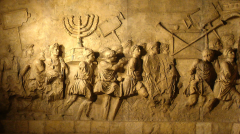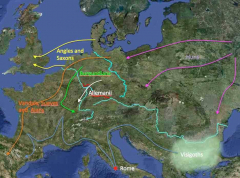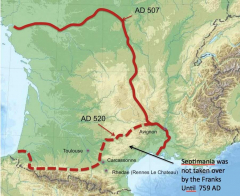Herod’s Temple
 Artist's impression of Herods Temple
Artist's impression of Herods Temple
A large portion of the Visigothic treasure had its origins in Herod’s temple in Jerusalem.
Traditionally the Temple was decorated and filled with precious artefacts. The most holy place of Solomon’s temple (the first temple) was lined with cedar from Lebanon and covered with 600 talents of gold. This gold plating alone, about 540,000 troy ounces, would be worth about $270 million today. The doors of the temple were also covered with gold plates.
The splendor of Solomon’s kingdom brought him recognition and fame that attracted much foreign attention. For example, during her visit “to test Solomon with hard questions” the Queen of Sheba brought Solomon 120 talents of gold, ($54,000,000), “and a very great store of spices and precious stones,”
This first temple was looted and destroyed, to be replaced by a second temple which again was plundered. How much of the “wealth was stored away and was subsequently recovered is unknown. In roman times Herod the Great extended the second temple and restored it to it’s former glory.
Vespasian and Titus
 The invasion and burning of the TempleIn AD 70 the Roman Emperor Vespasian, believing that the state of Judah was the greatest and most enduring threat to the Roman Empire, ordered his son Titus not just to wage war on Judah but to completely destroy it. It took Titus two years but he succeeded. He brought back to Rome the entire contents of the temple.
The invasion and burning of the TempleIn AD 70 the Roman Emperor Vespasian, believing that the state of Judah was the greatest and most enduring threat to the Roman Empire, ordered his son Titus not just to wage war on Judah but to completely destroy it. It took Titus two years but he succeeded. He brought back to Rome the entire contents of the temple.
 A model of Herod's temple The pillaging of the temple, its total destruction and the burning of Jerusalem, with terrible suffering and loss of life occurred in 70 AD. Tradition has it that the intense flames of the temple fire melted the gold and silver of the temple so that it ran between the cracks of the very fabric of the structure. Roman soldiers then totally dismantled the temple stone by stone to extract the gold, (see Matthew 24:1-2). No one seems to know with certainty if any of the vessels or sacred objects from Herod’s temple were hidden in subterranean passageways during the long siege of Titus. It is probable that the majority was carried off to Rome. It is estimated that at the time of it’s destruction, the temple contained 50 tons of gold and silver.
A model of Herod's temple The pillaging of the temple, its total destruction and the burning of Jerusalem, with terrible suffering and loss of life occurred in 70 AD. Tradition has it that the intense flames of the temple fire melted the gold and silver of the temple so that it ran between the cracks of the very fabric of the structure. Roman soldiers then totally dismantled the temple stone by stone to extract the gold, (see Matthew 24:1-2). No one seems to know with certainty if any of the vessels or sacred objects from Herod’s temple were hidden in subterranean passageways during the long siege of Titus. It is probable that the majority was carried off to Rome. It is estimated that at the time of it’s destruction, the temple contained 50 tons of gold and silver.
The spoils of victory
 The relief carving on the arch of Titus showing the treasures of the TempleThe Arch of Titus still exists in the Roman Forum. A relief panel on the Arch clearly displays the spoils, the seven-branched candelabrum or Menorah, the silver trumpets and the Table of the Shewbread. The treasure was then kept in Rome for three hundred years. The Arch has been the model for many later triumphal arches including, most notably, the Arc de Triumph in Paris.
The relief carving on the arch of Titus showing the treasures of the TempleThe Arch of Titus still exists in the Roman Forum. A relief panel on the Arch clearly displays the spoils, the seven-branched candelabrum or Menorah, the silver trumpets and the Table of the Shewbread. The treasure was then kept in Rome for three hundred years. The Arch has been the model for many later triumphal arches including, most notably, the Arc de Triumph in Paris.
 Herod Aggrippa and Beronice at the trial of St Paul. Titus also brought back from Jeusalem a young lady called Berenice who was the great grandaughter of Herod the Great.
Herod Aggrippa and Beronice at the trial of St Paul. Titus also brought back from Jeusalem a young lady called Berenice who was the great grandaughter of Herod the Great.
Berenice’s other claim to fame was that she sat alongside her brother Herod Agrippa II during the trial of St Paul. The image is of a stained glass window in St Paul’s Cathedral in Melbourne, Australia.
She lived with Titus as his wife both before and after he became Emperor, but was never accepted by the Roman People. The couple had no children. Or did they?…But all that is another story!
The Goths
 In AD 340 a Germanic tribe, the Goths sought refuge on the south bank of the Danube to escape from the advance of the Huns. There followed sixty years in which the Goths were recruited into the Roman Army.
In AD 340 a Germanic tribe, the Goths sought refuge on the south bank of the Danube to escape from the advance of the Huns. There followed sixty years in which the Goths were recruited into the Roman Army.
At the time in AD 406 when other “barbarians”, Sweves, Vandals and Alans invaded the Roman Empire the Visigoth’s Roman mentor, a man called Stilicho was deposed and murdered. In the chaos which followed the Visigothic families were slaughtered. One motivation of the attack was that the Visigoths followed the Arian version of Christianity, considered by the Roman Church to be a heresy.
 As a result, in AD 410 the Goths sacked Rome and stole its treasures. Their leader Ataulf followed Titus’ example. He not only took the treasure but he took a young lady, this time Aelia Galla Placida, the daughter of the Roman Emperor Thedosius. Placida and Atulf had a son,Thedosius who is supposed to have died young but did he?…Once again that is another story.
As a result, in AD 410 the Goths sacked Rome and stole its treasures. Their leader Ataulf followed Titus’ example. He not only took the treasure but he took a young lady, this time Aelia Galla Placida, the daughter of the Roman Emperor Thedosius. Placida and Atulf had a son,Thedosius who is supposed to have died young but did he?…Once again that is another story.
A search for tolerance
 The Visigothic homeland and the attack of the FranksThe Visigoths settled in the Garonne Valley, made Toulouse their capital and recovered Hispania (Spain) from the “Barbarians”.
The Visigothic homeland and the attack of the FranksThe Visigoths settled in the Garonne Valley, made Toulouse their capital and recovered Hispania (Spain) from the “Barbarians”.
Some believe that the reason they moved to this part of the Roman Empire is because this is where Mary Magdelene sought refuge after the cruxifiction and they believed that her disciples also preached Arian beliefs. The were looking for tolerance and sanctuary!
As the Roman Empire crumbled the Visigoths took control of everything to the south of the Loire and to the west of the Rhone. The Language, culture and religion of Occitan flowered under their rule.
The Easter Parade
The treasure they had taken from Rome, a large portion of which had been stolen from Jerusalem, was paraded in Toulouse every Easter Sunday for over seventy years. In 486 the Franks defeated Syagrius, a Roman general who still commanded Neustria which lay to the north of the Loire. it is possible that Britain also was included in the embryo state governed by Syagrius.
The Franks then moved south and defeated the Visigoths at the battle of Vouille, near Poitiers. King Alaric II was killed and his son was taken south of the Pyrenees. Within three years The Franks were besieging Carcasonne but they failed to take it. The last time the treasure was seen was in Carcassone.
And so to Rhedae
 Terrain in the foothills of the Pyrenees ex Google EarthThe legend is that the treasure was moved to Rhedae, in the northern fringes of the Pyrenees, because the plain of Lauzat around Rhedae was easier to defend. Also there were several passes from the plain of Lauzat leading through the Northern range of the Pyrenees forming a “backdoor” through which the treasure could be moved if necessary. Rhedae, a sizeable city, was subsequently destroyed in the middle of the Fourteenth century. All that now remains is the small village of Rennes le Château.
Terrain in the foothills of the Pyrenees ex Google EarthThe legend is that the treasure was moved to Rhedae, in the northern fringes of the Pyrenees, because the plain of Lauzat around Rhedae was easier to defend. Also there were several passes from the plain of Lauzat leading through the Northern range of the Pyrenees forming a “backdoor” through which the treasure could be moved if necessary. Rhedae, a sizeable city, was subsequently destroyed in the middle of the Fourteenth century. All that now remains is the small village of Rennes le Château.
For safe keeping the treasure was hidden in the foothills of the Pyrenees somewhere close to Rhedae. Meanwhile the Visigoths had moved their headquarters to first Barcelona then Toledo. However, even today the pass through the Gorge d’Algy pass is only a single track road carved in the side of the cliff and there is a schedule for when it allows traffic in each direction. Perhaps there was no road at that time which was accessible for heavy loads and so the majority of the treasure remained in its hiding place.
For nearly 200 hundred years the Franks tried to get control of the area but failed. The treasure may still be there.
